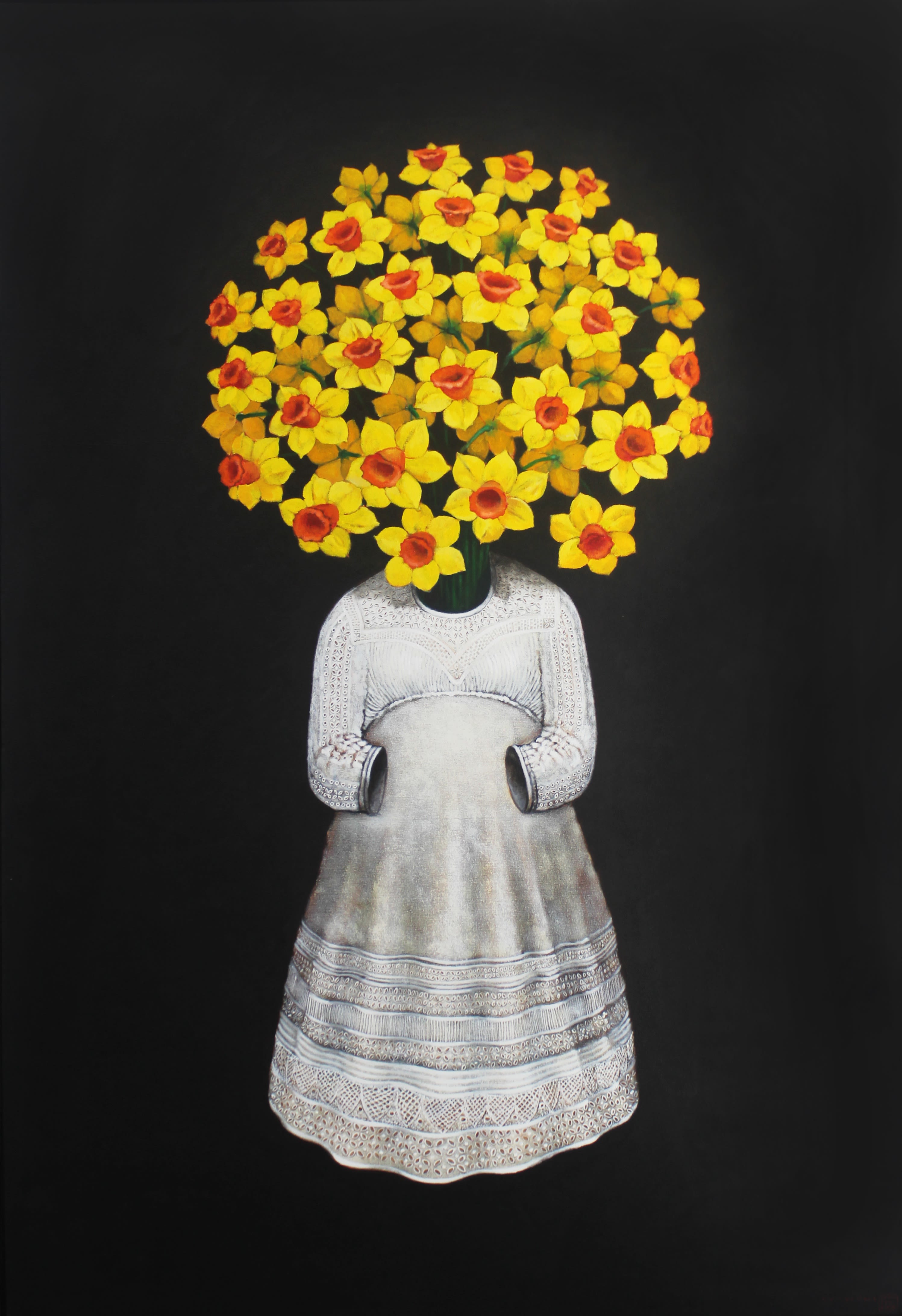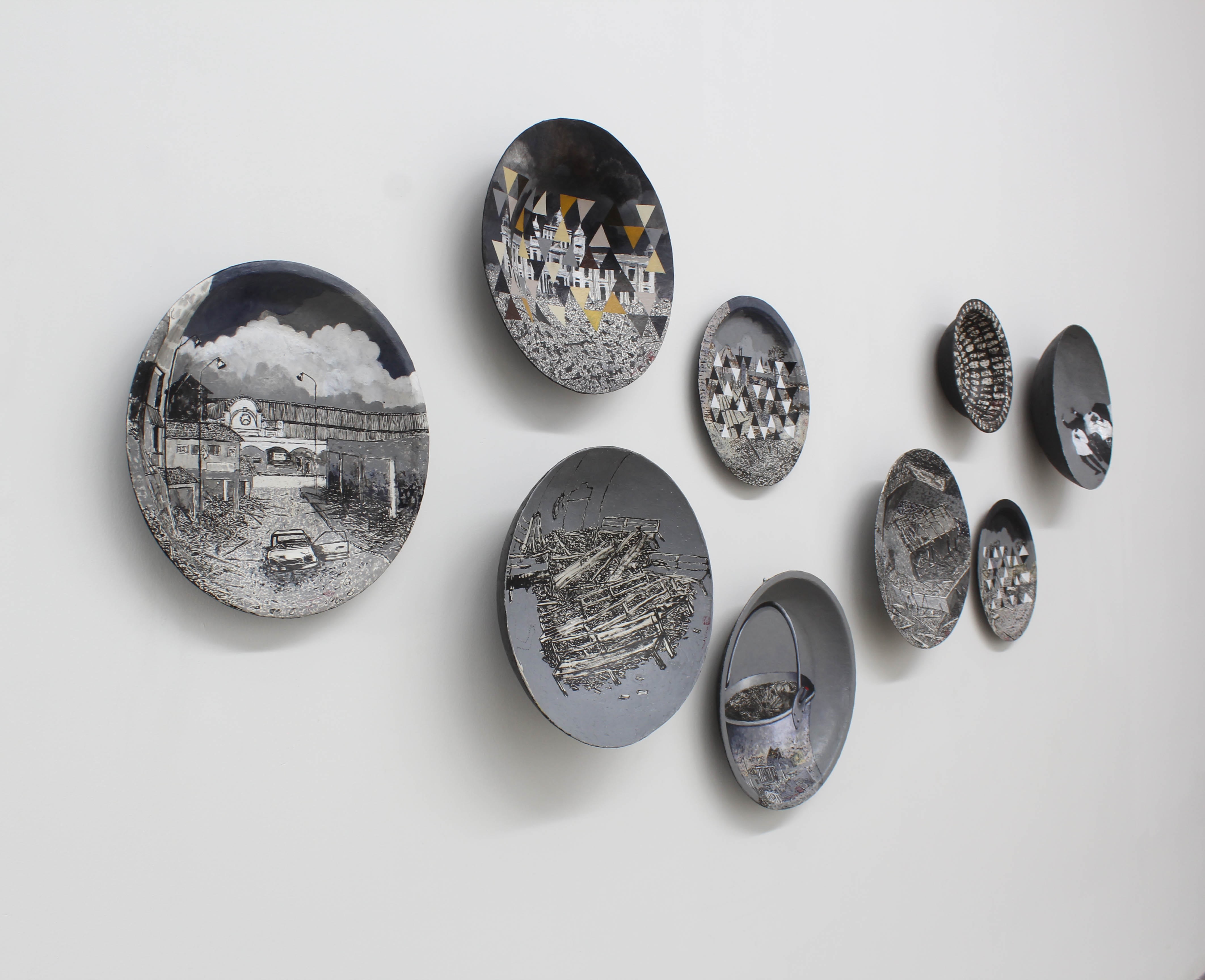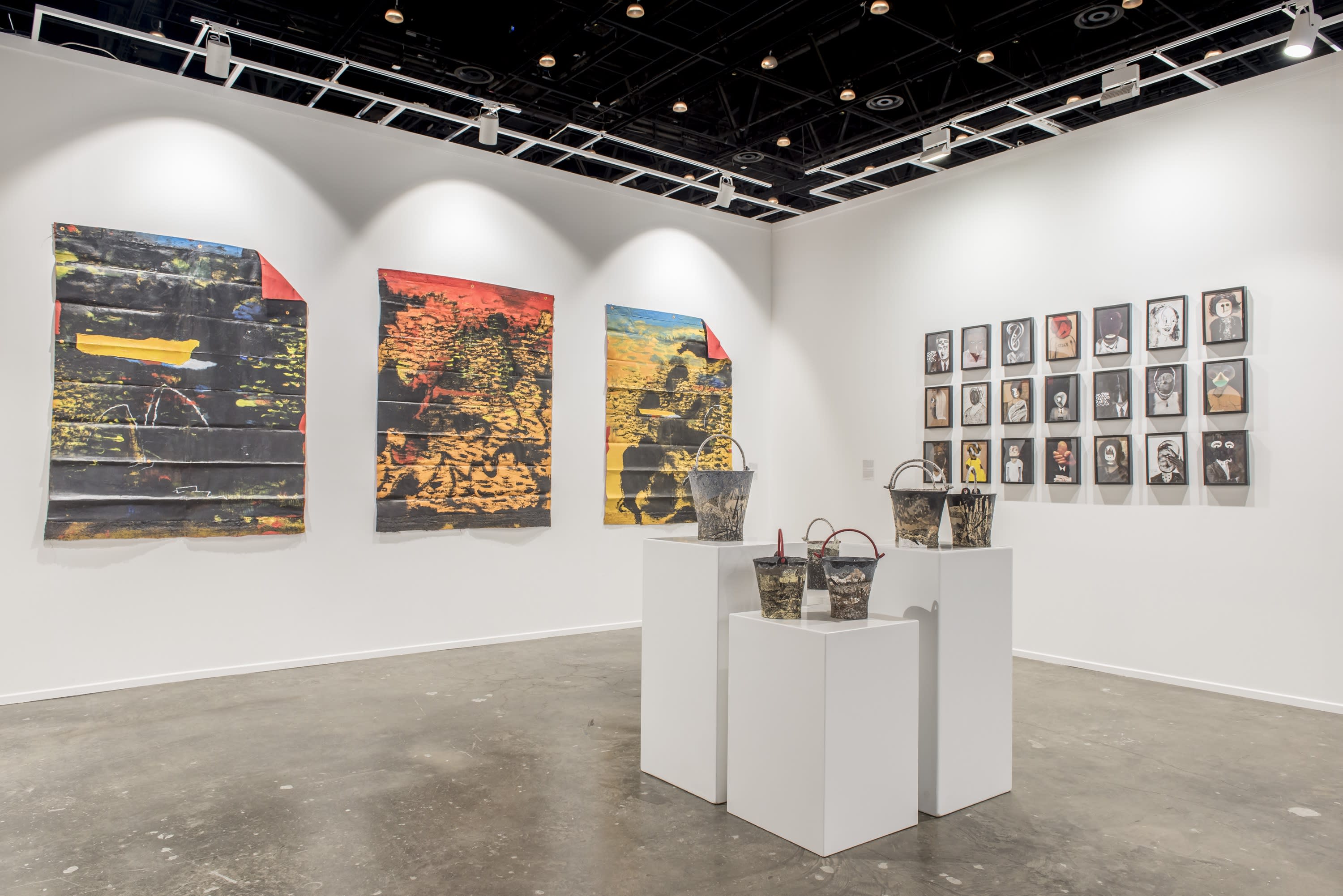|
|
|
Gayan Prageeth’s work is characterised by a Sri Lankan specific iconography and bears a sensitive awareness of ongoing environmental and political issues. The combination of intricate acrylic painting with fine ink drawings on rice paper, pasted on the canvas, creates a sharp visual style through which the artist critiques the socio-political environment in Sri Lanka. He makes use of ready-made material in his installations in a subtle commentary of the ethnic divide in the country. His work illustrates the turmoil of the civil war through installation and geometric symbolism – a combination of works that demonstrate not only Sri Lanka’s ruptured history but also the current state of many countries around the world. Gayan earned a BFA in Painting (2009) from University of Visual and Performing Arts, Colombo, Sri Lanka. His work has been exhibited at Art Dubai, UAE (2018), Colombo Art Biennale, Sri Lanka( 2016), Mandala Art Gallery, Singapore (2015), and the 13th Asian Art Biennale, Bangladesh (2008) and his works belong to private collections in Asia and Europe.
|
WHAT IS A TYPICAL DAY LIKE FOR YOU?I have two kinds of days: the weekends and weekdays. On the weekdays I would work about 3 hours in the evening. On the weekends I would work continuously starting from 8 or 9 am. I tend to enjoy the weekends more. The last couple of weeks have been stressful since I’ve been working on my new exhibition. On the weekends I start working at 8 in the morning and go on till 2 at night. The last few weeks I have been waking up at 4 am and helping my wife with a few things before I start my own work. I only sleep for about 4 hours these days. I need to catch up on all that sleep when this exhibition is over.
|
 |
I tend to work on an easel while my wife works on a table beside me. She doesn’t usually use an easel and prefers to keep all her materials on a table. I help my wife with her work. I only really reflected on whether I work daily on my practice just now when you asked me the question. We both work daily but we’re unsure whose work it is we are working on. It can be mine on some days and hers on other days. On some days I would stretch canvases for my wife. I also construct all our wooden frames which is something I enjoy doing immensely. I find the act of building the wooden frames quite meditative. |
What inspires you?I find a lot of inspiration in social media. I don't read as often as I should. I don’t share anything on social media but I do read what my friends share on social media. I watch a lot of news relating to Sri Lanka. My inspiration parallels what I witness on the news and social media. I don’t consume the news or social media to find inspiration for my work. It’s just a part of my daily life. Sometimes my art might completely contradict narratives that exist in social media.
|
|
What do you do in the lead-up to starting work on a new project?I always start with a concept. For example, in this exhibition, the concept I worked on was the Argalaya. Many artists created work in response to the Aragalaya and a lot of people asked me when I would explore this subject. I felt many artists responded to the Aragalaya in real-time with their personal outrage and their own political views which they felt compelled to share. This may or may not have been the case for these artists but for myself, I did not feel an immediacy in exploring the Aragalaya or my feelings toward it. For example, my exhibition 1983 which I produced a couple of years ago deals with events that happened when I was only three years old. So I’m not bound by my relation to the subject I am exploring. I struggled to adequately conceptualise 1983 having failed to do it during my time at university. It was only after I travelled to China and witnessed their calligraphic styles of drawing that I felt I was equipped with the visual language to examine that subject. |
|
|
|
|
WHAT PROMPTED YOU TO EXPLORE POLITICS IN YOUR ART?
I felt that our leaders always try to stoke violence and create divisions. Those were conversations I wanted to explore. I don’t know if my art has the power to change the political situation but I at least wanted those that consume my art to know that I wanted to create that kind of change. I could just create beautiful art and find greater commercial success but I would not get the same kind of satisfaction I do with the kind of art I produce currently.
I recognise that it is difficult to sell such negative subject matter. But what I hope to achieve with my attention to technique is the contrast between the beautiful aesthetic imagery and the darker political narratives behind them. I deceive the viewer to an extent by hooking them in through the aesthetically appealing imagery and only later revealing the insidious truth behind them. By that point, the narratives can’t be detached from the imagery. The viewer is forced to confront the reality behind the engaging hyperrealistic imagery. It’s like seeing a pretty girl at your university. You’re almost compelled to ask around about her. |
Everyone thinks about politics. Even the conversation we’re having right now is political. It is inescapable. My art explores the dark side of politics but I only do it to shed light on this darkness. I believe that we must have those unpleasant conversations. For example, the violence that occurred during the Aragalaya from all sides was a conversation I wanted to have. |
|
|
|
YOUR WORK HAS ALWAYS DISPLAYED AN ATTENTION TO DETAIL AND PRECISION THAT IS COMMENDABLE. HOW DID THIS LEVEL OF TECHNIQUE AND ATTENTION TO DETAIL DEVELOP IN YOUR PRACTICE?I was in an academic setting for 6 years learning to work technically. I enjoy using that knowledge in my practice. I’m very loyal to academic and technical approaches. I am devoted to ideas of composition and balance. This doesn’t mean I am completely rigid and cannot enjoy works by other artists which aren’t very technical. I just don’t adopt that approach in my own practice. But that devotion to technicality has helped find a balance between narrative and aesthetic. |
|
|
|
|
Could you elaborate on your mediums?I mostly use acrylic paint. I use a technique that gives the impression of an oil painting. Oil paints require the painter to build layer by layer to build the colour which isn’t the case for acrylic paint. The difficulty of using acrylic is that it doesn’t let the artist build and enhance the colour. But I try to enhance the colour by working in layers. It is a difficult task but the weight and vibrancy it gives my work is worth the effort.
I prefer acrylics because the humidity in Sri Lanka makes it difficult to work with oil. It creates fungus in the paint and it takes a long while to dry. Even finding good quality oil paints is a struggle. I would like to work with oil paint in the future but I’m now used to the convenience of acrylic paint.
|
|
Gayan's studio (2022) |
|
In your previous exhibitions Eyes Only and Since 1983 you displayed three dimensional installations. What drew you to installations as a medium?I want to find the most powerful way to show and explore any given concept. The audience needs to be awed and shocked by it. We don’t expect a random household item like a bucket to be a medium for an artwork. The audience is surprised when they see these kinds of installations. The play of shadow and space you get from the 3D installation adds to the work, especially when viewed from different angles. That’s the beauty of installations.
|
|
Installation view on Eyes Only, Saskia Fernando Gallery (2021)
|
Do you listen to music while you work?I did listen to music when I was preparing for my last show but not this time. No one was at home the last couple of days so I didn’t feel like playing any music. My wife and kids stayed with my mother-in-law during the day. It is a little hard to work with my youngest daughter around. She is always trying to make a mess. My oldest is fine. She will come close and look at the canvas but she never tries to make a mess. I’m very meticulous with my work so it becomes difficult to have kids in the studio. I need to have the space to myself till at least 75% of the work is done. After that the process is out of my control. Sometimes I just have to let artwork sit there for a few days before it all comes together for me.
|
What motivates you as an artist?I just enjoy making art. When I went to university I just wanted to get a degree to get a job. Maybe be a teacher. A lot of people studying art at university have a similar idea. Many of them won’t become artists. Many of them realise halfway through their mistake and find a different profession. To be an artist you need to have a love for the craft and a hunger to chase it. I don’t think I was very aware of my talent at university. I didn’t have friends to encourage me even though I was doing well academically. I don’t even have my convocation photos with me even though I was the top student in my batch. I think there is a lot of freedom in that detachment. I have nothing to lose. When other artists face any setbacks they feel the pressure and the disappointment of failure. I don’t have that pressure driving me. I don’t say this to be proud or boost my ego. But I have always had a detached attitude.
|
Could you tell us a bit about your journey as an artist?In my second year, we were asked to create figurative paintings. I created my project without a single figure. The painting I had drawn was the area in front of a school gate when the schools had been shut down because of bomb threats so there was no one around. This was around 2006. There was only one figure in the painting and that was on a sign near the road crossing. My professors actually had a lot of good things to say about it. I was very encouraged by that. I was also pushed a lot by Kingsley Gunatillake who wasn’t teaching there at the time but would visit our studios.
I was also guided by Mr Udyashanth Fernando who I met during a show at the Lionel Wendt Art Centre. I was very young and inexperienced at the time and I was quite shocked when he wanted to purchase my artwork.. He asked me if I wanted payment by cheque or cash. I was quite naive so I told him to choose what he preferred. He pulled me aside and told me that isn’t the way it's done and gave me some advice. He was very generous with his advice. I met him again at the Young Contemporaries show at the National Gallery organised by the Keyt Foundation. He had bought three of my works from that show. He told me to prepare to do an exhibition in the Gallery Cafe for the next year. That was my start.
Afterwards, I had the opportunity to go to the Dhaka Art Fair with Jagath Ravindra. That’s when I really started to feel like an artist. During the art fair, I would stay up and talk with the professor who would give me a lot of advice and anecdotes about how he got started. I’m grateful for all that he shared with me.
|
|
Gayan's buckets displayed at Art Dubai (2018)
|
|
What is the impact you hope to achieve with your work?I would like to create some sort of real-world change even though I know that is a difficult thing to do. I have to at least try. Beyond that, I would be satisfied knowing that even if my work is considered a failure, at the end of the day I am happy with the works I have created. |
Do you have any advice for aspiring artists?I don’t know if anyone wants my advice. Even my wife doesn’t want my advice. Artists are very stuck in their way so I don’t think my advice would matter. What I would say is that art has the power to do a lot more than entertain and to embrace all the potential that can come from the artistic process.
|
What's next for you?I would like to work as a full-time artist. I do enjoy teaching and I have a good relationship with my students. But the idea of being a full-time artist will always cross my mind.
|

 Gayan's studio (2022)
Gayan's studio (2022)





